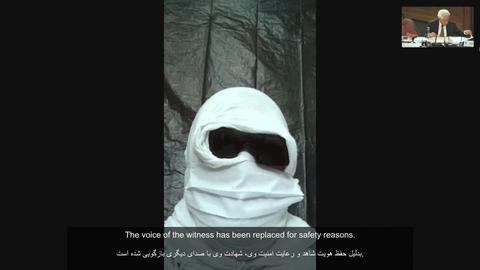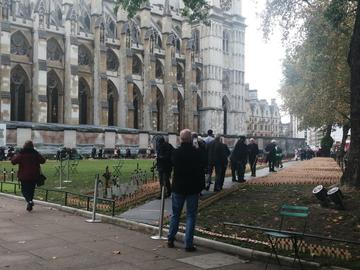Criminals conscripted by the Iranian regime to provoke riots during civilian protests are "executed" after they have exhausted their use, a unit commander has told the Aban Tribunal.
Witness 399 was introduced to the court in London as a major in the security forces who led a battalion during the November 2019 protests. The special unit’s function was broadly defensive, but attached to them were a group of the Interior Ministry’s notorious plainclothes “thugs”.
The Iranian state’s co-opting of dangerous criminals to help crush popular dissent was first confirmed five years ago. In a posthumously-published interview, Revolutionary Guards General Hossein Hamadani said the Basij had identified 5,000 “thugs and hoodlums” that were groomed and recruited into battalions to attack people during the post-2009 election Green Movement protests. “Later,” he said, “these three battalions proved that if we want to train mojaheds we must bring in such individuals who know how to work with razors and machetes.”
During Wednesday’s Aban Tribunal proceedings, a well-connected official had told the panel in London that thugs injured protesters in his city during November 2019 with knives and chains. On Friday, Witness 399 testified that conscripted prisoners were used “all over Iran, in many provinces”.
Violent prison inmates, he said, would be deployed to the streets during periods of public unrest. Among other things, in November 2019 they were used to target demonstrators and damage property, to make the protests appear more violent than they were and justify a violent response.
“These prisoners were recruited by me, or the unit under my command,” he said. “They were selected by the Ministry of Interior. They would penetrate the crowd and push the crowd towards destruction, towards vandalism, to create the pretext for the government to crack down through lethal force. That is to say, it was a scenario that was written by the government themselves.”
The convicts, he said, undertook these actions in exchange for “privileges” in prison or even the promise of freedom. But after going on a number of operations, he said, “they die – from a drug overdose [for example], or they’re hit by a car.”
The individuals selected for conscription, Witness 399 said, were “criminals, ruffians, people known as evil in their communities” and the weapons they were given “not used by any institution: that is to say, weapons that were out of use, so that if somebody is shot by a bullet, forensic medicine and the coroners cannot tell where it came from. They wouldn’t be able to relate it to the police force, or the military, or others who had attacked people.”
Witness 399 also said some of the convicts were equipped with explosive ammunition, which is outlawed globally as it has no purpose other than to kill. “These are bullets with explosives inside them,” he said. “On impact with the body, they create a big wound. These bullets are used only when you want to kill somebody, not when you want to wound them.”
These so-called “anti-riot units” were organized into groups of 10 and deployed on the instruction of the provincial security councils, he said. The provincial security councils in turn act on the orders of the Supreme National Security Council. Asked if they received any specific training, he told panel judges: “They don’t. They’re breaking windows and setting fire to shops. They don’t need any specific training for that.”
Witness 399’s face was obscured and his words repeated by an intermediary to protect his identity. The rest of his evidence will be given in a private session.
The Aban Tribunal is an independent people’s tribunal organized by Justice for Iran, Iran Human Rights and Together against the Death Penalty (EPCM). Over five days of hearings in London, a panel of international lawyers and human rights experts will determine what crimes were committed by the Iranian state during the November 2019 protests, and who is responsible.
Related coverage:
Aban Tribunal: Shock Day 2 Testimonies Reveal Scope of State Violence
Aban Tribunal: Police Major 'Prosecuted for Refusing to Shoot'
Aban Tribunal: Detainees 'Drugged and Made to Simulate Their Funerals'
Aban Tribunal: Iranians Testify on November 2019 Atrocities in London
The Names of All 133 Officials Accused of November 2019 Crimes
Hundreds Testify in "People's Tribunal" on November 2019 Atrocities
Aban Tribunal: 133 Iranian Officials Accused of November 2019 Crimes


























comments